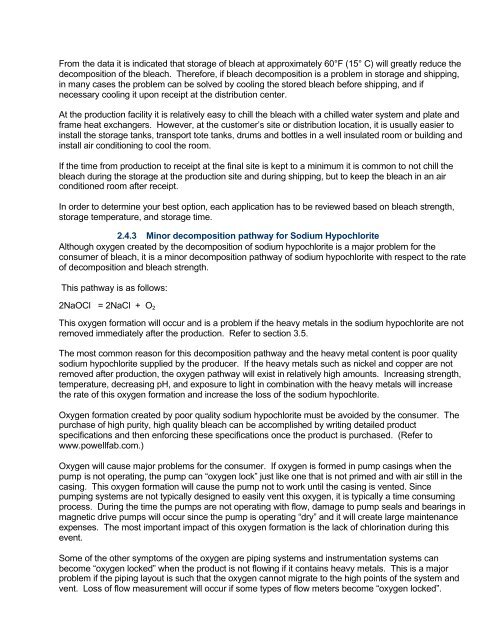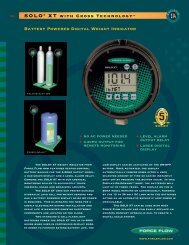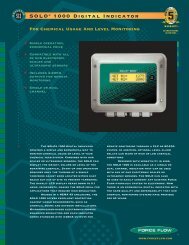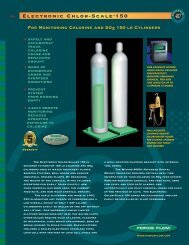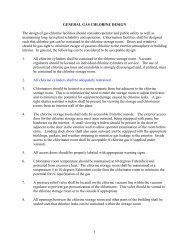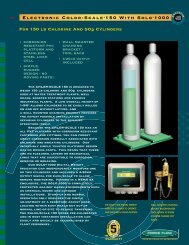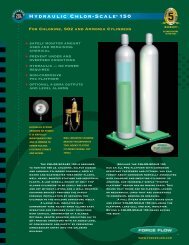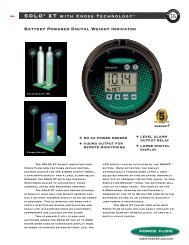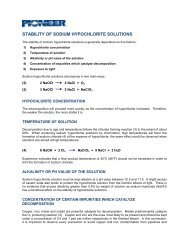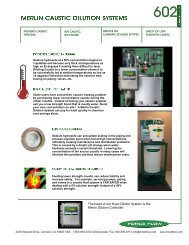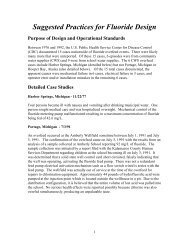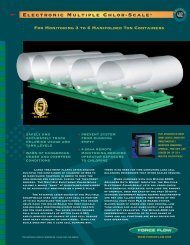Sodium Hypochlorite Handbook - Force Flow
Sodium Hypochlorite Handbook - Force Flow
Sodium Hypochlorite Handbook - Force Flow
You also want an ePaper? Increase the reach of your titles
YUMPU automatically turns print PDFs into web optimized ePapers that Google loves.
From the data it is indicated that storage of bleach at approximately 60°F (15° C) will greatly reduce thedecomposition of the bleach. Therefore, if bleach decomposition is a problem in storage and shipping,in many cases the problem can be solved by cooling the stored bleach before shipping, and ifnecessary cooling it upon receipt at the distribution center.At the production facility it is relatively easy to chill the bleach with a chilled water system and plate andframe heat exchangers. However, at the customer’s site or distribution location, it is usually easier toinstall the storage tanks, transport tote tanks, drums and bottles in a well insulated room or building andinstall air conditioning to cool the room.If the time from production to receipt at the final site is kept to a minimum it is common to not chill thebleach during the storage at the production site and during shipping, but to keep the bleach in an airconditioned room after receipt.In order to determine your best option, each application has to be reviewed based on bleach strength,storage temperature, and storage time.2.4.3 Minor decomposition pathway for <strong>Sodium</strong> <strong>Hypochlorite</strong>Although oxygen created by the decomposition of sodium hypochlorite is a major problem for theconsumer of bleach, it is a minor decomposition pathway of sodium hypochlorite with respect to the rateof decomposition and bleach strength.This pathway is as follows:2NaOCl = 2NaCl + O 2This oxygen formation will occur and is a problem if the heavy metals in the sodium hypochlorite are notremoved immediately after the production. Refer to section 3.5.The most common reason for this decomposition pathway and the heavy metal content is poor qualitysodium hypochlorite supplied by the producer. If the heavy metals such as nickel and copper are notremoved after production, the oxygen pathway will exist in relatively high amounts. Increasing strength,temperature, decreasing pH, and exposure to light in combination with the heavy metals will increasethe rate of this oxygen formation and increase the loss of the sodium hypochlorite.Oxygen formation created by poor quality sodium hypochlorite must be avoided by the consumer. Thepurchase of high purity, high quality bleach can be accomplished by writing detailed productspecifications and then enforcing these specifications once the product is purchased. (Refer towww.powellfab.com.)Oxygen will cause major problems for the consumer. If oxygen is formed in pump casings when thepump is not operating, the pump can “oxygen lock” just like one that is not primed and with air still in thecasing. This oxygen formation will cause the pump not to work until the casing is vented. Sincepumping systems are not typically designed to easily vent this oxygen, it is typically a time consumingprocess. During the time the pumps are not operating with flow, damage to pump seals and bearings inmagnetic drive pumps will occur since the pump is operating “dry” and it will create large maintenanceexpenses. The most important impact of this oxygen formation is the lack of chlorination during thisevent.Some of the other symptoms of the oxygen are piping systems and instrumentation systems canbecome “oxygen locked” when the product is not flowing if it contains heavy metals. This is a majorproblem if the piping layout is such that the oxygen cannot migrate to the high points of the system andvent. Loss of flow measurement will occur if some types of flow meters become “oxygen locked”.


